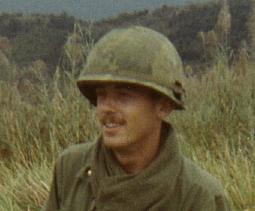

David E. Parrish
4/42 Artillery - 1/22 Infantry
4th Infantry Division
1969-1970
I received my draft notice
two days after I graduated from Penn State. I arrived in
Long Binh on 2 November 1969
as a newly commissioned 2LT, Field Artillery. I had been
in the Army for a year at that time; that’s how long it took
to go through basic training,
AIT, and OCS. At 23, I was older than the average 19-year
old in Vietnam but like everyone else, I was apprehensive to say
the least.
When I was informed that I was headed to the 4th
Infantry Division, I had never heard of it. It didn’t
carry the high profile of the 1st Cavalry
or 101st Airborne. The 4th was OK by
me. I figured that it probably didn’t have the
casualty rate of those better-known divisions.
So my journey began, criss-crossing the country with a trip to
Pleiku, then to LZ English, and on to FSB Beaver.
The day after arriving at FSB Beaver I was on the
re-supply helicopter to LZ Owens to join Alpha Company, 1st/22nd
Infantry Regiment
as its forward observer. Like every FNG, I was clueless.
As I wrote captions to my
photos, I struggled putting names to faces and identifying when
and where the pictures were taken.
Of course, almost 40 years was a big issue. I also decided
that the personnel rotation system that the U. S. Army used
during the Vietnam conflict
contributed a great deal to my “Who is that?” problem.
Contrary to prior and
subsequent conflicts, in Vietnam the U. S. Army employed a system
of rotating people and job assignments,
not entire units. We all experienced the revolving door.
For officers and career NCOs, there was a further rotation
-
a rotation within the rotation - as the Army tried to move career
or potential career personnel through line and staff assignments
to broaden experience and promote careers. While this is a
common approach in civilian business, it usually involves
multi-year assignments.
In Vietnam, the Army had 12 months to accomplish the same
cross training. So the revolving door spun faster.
For me, the rotation
practices were particularly eventful. Figuratively
speaking I never unpacked my suitcase.
In 12 months, I had four different assignments. I spent:
· 5 months as a forward observer,
· 3 months as fire direction officer (FDO) for C Battery,
· 2 months as the artillery liaison officer (LNO) for 1st/22nd, and
· 2 months as the artillery liaison officer (LNO) for 1st/12th Infantry.
In all of those jobs, people
came and went. While I was an FO, I had at least one
battery commander (my immediate superior)
that I never met. During my time as FDO and in my two
stints as LNO, I don’t think any one person assigned to the
section
was with me for more than 6 weeks, if that. It is no
wonder I have trouble putting names to faces.
1LT David E. Parrish
4th/42nd Artillery, Nov 69 thru Oct 70
Home | Photos | Battles & History | Current |
Rosters & Reports | Medal of Honor | Killed
in Action |
Personnel Locator | Commanders | Station
List | Campaigns |
Honors | Insignia & Memorabilia | 4-42
Artillery | Taps |
What's New | Editorial | Links |